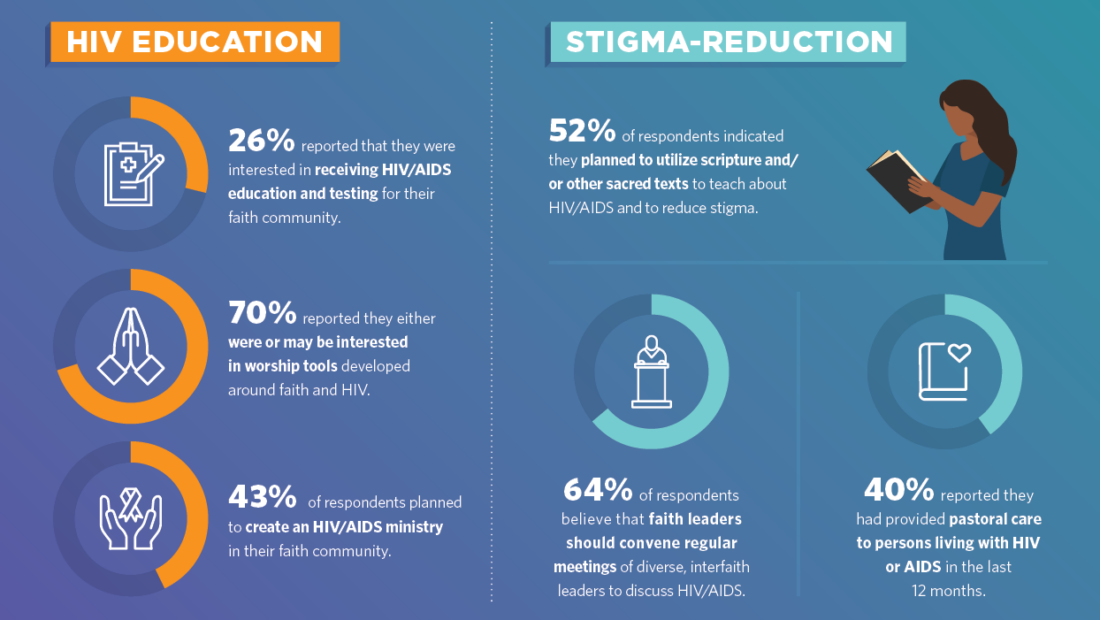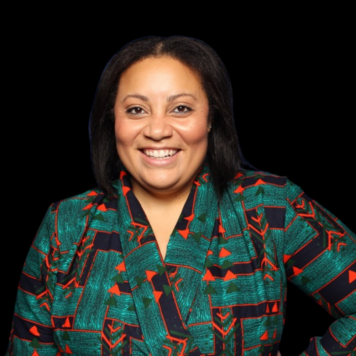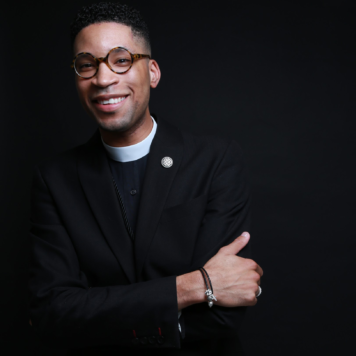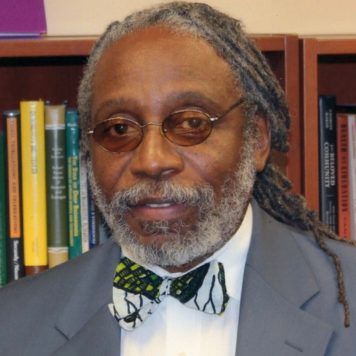
Overview
The faith community continues to play an essential role in shaping the public’s knowledge, attitudes, beliefs and behaviors. Faith-based organizations (FBOs) have been key components in a comprehensive HIV prevention strategy for building awareness, mobilizing communities, and reducing HIV-related stigma. The role FBOs play in local communities puts them in a unique position to influence their congregation to get tested, seek care, and remain virally suppressed. This has taken many forms, from initiatives to reduce HIV stigma among Black men in the South to congregation-wide testing to global efforts to end the HIV epidemic.
National Faith HIV/AIDS Awareness Day has been celebrated each year on August 29 since 2017 to recognize the role all FBOs play in HIV/AIDS education, prevention, treatment, care, and support, as well as reducing and eliminating stigma and discrimination.
History
Since 1987, the Centers for Disease Control and Prevention (CDC) has made a concerted effort to include faith and religious partners in the CDC portfolio of HIV prevention partners. In 1999, CDC funded five faith-based direct service programs: four capacity-building programs to provide technical assistance and training to FBOs, and one divinity school to establish an HIV and substance abuse prevention curriculum and training program for faith leaders serving disproportionately affected communities. More recently, CDC has funded FBOs to conduct HIV prevention activities.
FBOs and PEPFAR
FBOs and their networks have been key partners in the U.S. President’s Emergency Plan for AIDS Relief (PEPFAR) since the program was announced in 2003. From the earliest days of the HIV epidemic, FBOs have led the way in caring for those who were sick and dying. FBOs also played a central role in the emergency roll-out of HIV services under PEPFAR in its infancy. Through PEPFAR, CDC continues to work closely with FBOs and their networks to control and work towards ending the HIV epidemic. Across sub-Saharan Africa, FBOs are the largest non-governmental provider of health services and, therefore, a key component of a global response.

The Black Church and HIV
HIV has a disproportionate impact on the Black community in the United States due to significant structural and societal barriers to accessing HIV prevention and care services. In 2020, Black people represented 42% of new HIV diagnoses, despite making up only 14% of the U.S. population. The disparity is clear in HIV prevalence as well—in 2020, 40% of all people living with HIV in the U.S. were Black.
The Black Church in America, which refers to the collective body of diverse Christian congregations with which Black Americans are connected, has long provided a platform for Black civic engagement on social issues and injustices, including HIV. According to a 2014 study, 87% of Black American considered themselves Christian and 83% said they prayed daily. Homosexuality is particularly stigmatized in Black communities, and many Black ministers voiced their disapproval of homosexuality from the pulpit in the early days of the epidemic, despite the presence of gay and bisexual worshippers in the congregation. However, by the end of the 1990’s, as the epidemic continued to grow, Black churches began to embrace those with HIV/AIDS. In 1989, 50 churches participated in the first Black Church Week of Prayer for Healing AIDS, led by Balm in Gilead, a nonprofit organization that helps black churches provide AIDS education and support networks. During the 1999 Week of Prayer, 5,000 churches held worship services, lectures, and concerts to raise awareness about HIV/AIDS.

The challenges the Black community face can also hinder access to HIV testing, PrEP, and necessary treatment and care services. In 2022, Black people represented 14% of PrEP users, but 42% of new HIV diagnoses in 2021. In 2020, a smaller percentage of Black Americans diagnosed with HIV were virally suppressed than either Hispanic/Latinx or white Americans living with diagnosed HIV. Due to this, testing and access to care and prevention services has always been a particular point of concern for the Black Church. Faith leaders make a concerted effort to educate their congregations about how to access testing, with many holding annual testing events in which leaders get publicly tested in front of their congregations to help dispel stigma and encourage the entire community to engage in yearly testing.
Significant progress has been made in testing among Black Americans, partly as a result of these efforts. In 2020, Black people had the highest percentage of people that have ever tested for HIV (60%) of any group. In comparison, the national average was just 39%.
The FBO Survey
Individual churches, seminaries, and FBOs throughout the country continue to connect their congregants with HIV testing, care, and counselling services.
While many studies have examined faith-based attitudes about HIV in the United States, few have assessed faith leader perceptions about conducting HIV programming and/or ministries in their faith communities. Additionally, there are an estimated 10,000 congregations in the United States who have people living with HIV as members. However, little is known about the characteristics of the FBOs providing HIV programming nor the type of programming or activities these FBOs are implementing. Dr. Allison Mathews of Wake Forest and the COMPASS initiative recently administered a survey to 100+ FBOs in the South to better understand faith leader perspectives about implementing HIV programming in their faith communities and what types of HIV programming are happening in faith-based settings.
The survey found:
- 45% of respondents indicated that in the last 12 months they have provided programming about preventing HIV transmission, such as teaching about prevention strategies or promoting HIV testing
- 44% reported they had provided pastoral care to persons living with HIV or AIDS in the last 12 months.
- 31% reported providing testing in the last 12 months.
- 17% reported they had provided housing to people living with HIV in the last 12 months.
- 52% of respondents indicated they planned to utilize scripture and/or other sacred texts to teach about HIV/AIDS and to reduce stigma.
- 64% of respondents believe that faith leaders should convene regular meetings of diverse, interfaith leaders to discuss HIV/AIDS.
- 26% reported that they were interested in receiving HIV/AIDS education and testing for their faith community.
- 43% of respondents planned to create an HIV/AIDS ministry in their faith community.
This study provides valuable insights into the attitudes and perceptions of individuals towards discussing HIV/AIDS in faith settings. The findings highlight the need for tailored approaches to address diverse viewpoints and promote open dialogue within faith communities. Understanding these attitudes and perceptions is crucial for developing effective HIV/AIDS prevention and education programs that align with the beliefs and values of faith-based populations.
Overall, the survey results suggest that faith leaders continue to play an important role in the fight against HIV/AIDS. They are providing education and support to their communities, and they are working to destigmatize the disease.
The FBO Service Locator
As a part of this project, Dr. Mathews and the COMPASS initiative partnered with AIDSVu to create an FBO service locator that allows individuals to find an open and affirming FBO near them. The locator currently displays contact information and geographic location for 81 FBOs across the U.S. This locator allows those seeking testing, counseling, housing, and care services to find these services within their faith community. This locator will continue to be updated as more FBOs are surveyed.
Faith-Based Organization Locator
View faith-based organizations (FBOs) in your community by clicking into your state. Surveyed locations will appear below.




